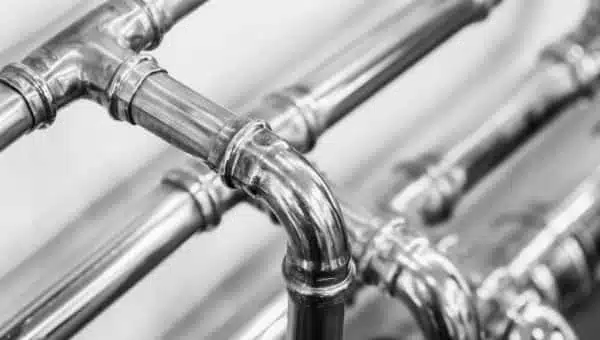Copper pipes have long been a favorite in home plumbing systems due to their durability and resistance to corrosion. However, like all materials, they’re not immune to wear and tear.
When that time comes, knowing how to properly replace them can save you from costly leaks and water damage. In this blog post, we’ll delve into the do’s and don’ts of copper pipe replacement.
Table of Contents
Understanding the Use of Copper Pipes in Plumbing
It’s no secret that copper pipes have reigned supreme in the plumbing world for many years. Their stellar reputation stems from a myriad of desirable qualities that make them a go-to for many plumbers and homeowners. For starters, copper pipes have an impressive ability to resist corrosion, keeping your water supply clean and safe for consumption. What’s more, they can stand up to bacteria, preventing any unwelcome guests from hitching a ride on your water flow.
Yet, it’s not just their practical benefits that make copper pipes a popular choice. Their green credentials also weigh heavily in their favor. Being recyclable, they can enjoy a new lease of life after their service in your home, reducing their environmental impact.
Despite these benefits, it’s crucial to remember that copper pipes aren’t invincible. They can still fall prey to various types of damage. Acidic water can be a copper pipe’s kryptonite, causing them to wear prematurely. Overheating can also take its toll on these pipes, as can physical trauma. After all, copper might be durable, but it’s not impervious to the trials and tribulations of everyday life.
As a homeowner, understanding these strengths and weaknesses of copper pipes can empower you to make informed decisions about your plumbing system. It helps you know when it’s time to appreciate your copper pipes and when it might be time to bid them farewell and embrace a replacement. In the world of plumbing, knowledge is indeed power!
Identifying the Need for Copper Pipe Replacement
Sometimes, your copper pipes may wave a little white flag, indicating that they’re due for a replacement. Frequent leaks are one clear cry for help from your copper pipes. If they’re springing leaks more often than usual, it might be time to consider a repipe. Visible corrosion is another sign. If your pipes look like they’re in a state of decay, that’s not just an eyesore, it’s a signal that your pipes could be nearing the end of their lifespan.
Moreover, your water may be speaking volumes about your pipe’s health. Discolored water is a huge red flag, indicating possible corrosion within your pipes. A surge in your water bill without a corresponding increase in water use could be hinting at a concealed leak. It’s a bit like having a sneaky little hole in your wallet that your money keeps slipping through.
Similarly, a sudden drop in water pressure might be whispering of a blockage within your pipes. It’s like trying to sip a smoothie through a straw that’s been pinched shut; you just won’t get the flow you’re expecting.
Paying heed to these signs can save you from extensive damage and expensive repairs down the line. As the saying goes, “A stitch in time saves nine”. So, don’t turn a blind eye to these tell-tale signs. After all, it’s better to be safe than sorry when it comes to maintaining your home’s plumbing system.

The Pros and Cons of Replacing Copper Pipe
Just like everything in life, copper pipe replacement comes with its unique set of pros and cons. On the brighter side, let’s begin with the perks. Firstly, new copper pipes can significantly enhance the quality of your water, which is crucial for your health and overall well-being.
Additionally, it’s a potential boon for your property’s worth. The simple act of replacing worn-out copper pipes can increase the attractiveness and value of your home to potential buyers. But most importantly, it decreases the chances of leaks in copper pipes and subsequent water damage. That means peace of mind for you, knowing you’re not likely to face unexpected floods in your home anytime soon.
However, just like the dark side of the moon, there are some downsides that need to be brought to light. Copper pipe replacement can be a fairly hefty investment of time and money. It’s not as simple as swapping an old pipe for a new one. It demands meticulous planning, precise measurements, and a fair bit of elbow grease.
Not to mention the cost of the new pipes themselves. Then there’s the risk of improperly installed pipes if the task isn’t handled professionally. This could open the door to an entirely new set of issues, putting a dent in the very benefits you were hoping to reap. Hence, the need to ensure the job is done right cannot be overstated.
To sum it up, while there are clear benefits to replacing your copper pipes, the process is not without its challenges. Understanding these pros and cons can help you make an informed decision that aligns with your needs, budget, and long-term plans for your home.
Do’s of Copper Pipe Replacement
If you’ve made the decision to swap out your old copper pipes, it’s crucial to adhere to a set of best practices to ensure a successful outcome. First off, it’s vital to lay out a strategic plan. Before you so much as touch a wrench, make sure you have all the necessary tools and materials at your disposal. Missing an essential item mid-replacement can throw your entire project into disarray.
Next up, don’t forget to shut off your water supply before you start. A gushing fountain of water from an open pipe is not an appealing sight, and it’s a surefire way to end up with an indoor pool you didn’t ask for. Use your home’s main water valve to prevent any unwelcome surprises.
Another important ‘do’ is using a tubing cutter for your pipe cuts. This tool is a must-have for ensuring clean, straight cuts, helping you avoid additional pipe damage that could complicate your replacement efforts.
Finally, after you’ve installed your new copper pipes, take the time to check for leaks. Turn your water supply back on and closely monitor the replaced section for any signs of dripping or moisture. This step is absolutely critical, as early detection of leaks can prevent future water damage and save you significant time, stress, and money down the line.
Remember, copper pipe replacement isn’t a race. It’s a process that requires careful planning, precision, and patience. By sticking to these do’s, you’ll be well on your way to a successful copper pipe replacement. And remember, if at any point you feel out of your depth, it’s never a bad idea to call in the pros.
Don’ts of Copper Pipe Replacement
As we delve into the realm of copper pipe replacement, it’s essential to remember there are a few actions to sidestep. To start off, your well-being should be a priority. Don’t overlook the importance of protective gear like safety glasses and gloves while you work. Another non-negotiable is ensuring proper ventilation to avoid exposure to harmful fumes during soldering.
A common pitfall to avoid is the temptation to mix and match pipes and fittings that aren’t compatible. Using mismatched parts might seem like a quick fix, but it can cause havoc in the form of leaks. Remember, each piece of your plumbing puzzle needs to fit together seamlessly, so stick with the right components for the job.
In the throes of copper pipe replacement, patience is truly a virtue. Don’t rush through the process, as hasty work can lead to costly mistakes. Instead, take your time to ensure each step is done meticulously. Cutting corners today could end up being a detour to more problems down the road.
Lastly, don’t disregard local plumbing codes and regulations. While these guidelines might seem tedious, they’re in place for a reason. Compliance ensures the safety of your home and prevents potential legal issues that might crop up from unapproved plumbing work.
On a final note, if you’re considering copper pipe replacement, keep in mind that while some mistakes might seem insignificant at first, they can snowball into bigger problems over time. To avoid such pitfalls, a dash of caution and a good dose of professional advice can be your best tools.
The Importance of Hiring a Professional Plumber
The prospect of embarking on a DIY copper pipe replacement journey might seem enticing, filled with the allure of saved dollars and self-accomplishment. However, the inherent complexity and precision required for the job often tilt the scales in favor of calling in professional plumbers. The benefits they bring to the table are invaluable.
With a certified plumber, you’re getting more than just a service. You’re tapping into a reservoir of expertise and experience that can make the difference between a smooth, successful project and a frustrating, costly one.
These seasoned experts understand the ins and outs of plumbing systems. They can spot potential pitfalls and preemptively address them, reducing the likelihood of post-replacement problems. In essence, they’re equipped to transform your plumbing woes into a seamless, stress-free experience.
Not only do professional plumbers have the right skills and knowledge, but they’re also proficient with the correct tools and materials for the job. They know which part fits where, ensuring that every pipe and fitting aligns perfectly, eliminating the risk of leaks and costly water damage.
Imagine it as a well-orchestrated symphony, where every note hits at the right time to create harmonious music — only, in this case, the music is your flawlessly functioning plumbing system.
Saving time is yet another reason to consider hiring a professional. Plumbing work can be time-consuming, especially if you’re not familiar with the process. With an expert at the helm, you can save precious hours and reduce disruption to your daily routine.
Additionally, remember those local plumbing codes and regulations we mentioned earlier? A professional plumber is adept at adhering to these guidelines, ensuring your replacement is compliant, safe, and up to standard. This way, you dodge potential legal headaches that could stem from non-compliant work.
FAQ’s
What is the cost of replacing ancient copper pipes?
Replacing old copper pipes with new ones costs between $10 and $20 per linear foot, or $10,000 and $20,000 for 1,000 linear feet of pipe, not including the removal of existing supply lines.
What is the best pipe to use in place of copper?
If you want an alternative to copper plumbing pipes, try a pex pipe replacement. PEX piping has several advantages over copper piping, including being less expensive, easier to install, and less prone to leak pollutants into the water.
How difficult is it to replace copper pipes?
Although removing and replacing a piece of copper pipe is not difficult, you will need some supplies that not everyone has on hand, such as a copper-pipe tubing cutter, flux and a flux brush, solder, and a propane torch.
Can I use PEX instead of copper pipes?
Replacing aging plumbing pipes is a regular home improvement project that must be completed sooner or later. Most of the time, outdated copper pipes are replaced with newer, easier-to-work-with PEX pipes.
Conclusion
While it may seem like an extra expense upfront, securing the services of a professional plumber for your copper pipe replacement could save you substantial costs in the long run. Not to mention, the peace of mind knowing your home’s plumbing is in capable hands is priceless. The moral of the story? When in doubt, it’s wise to trust the professionals. After all, peace of mind is indeed the best investment!
